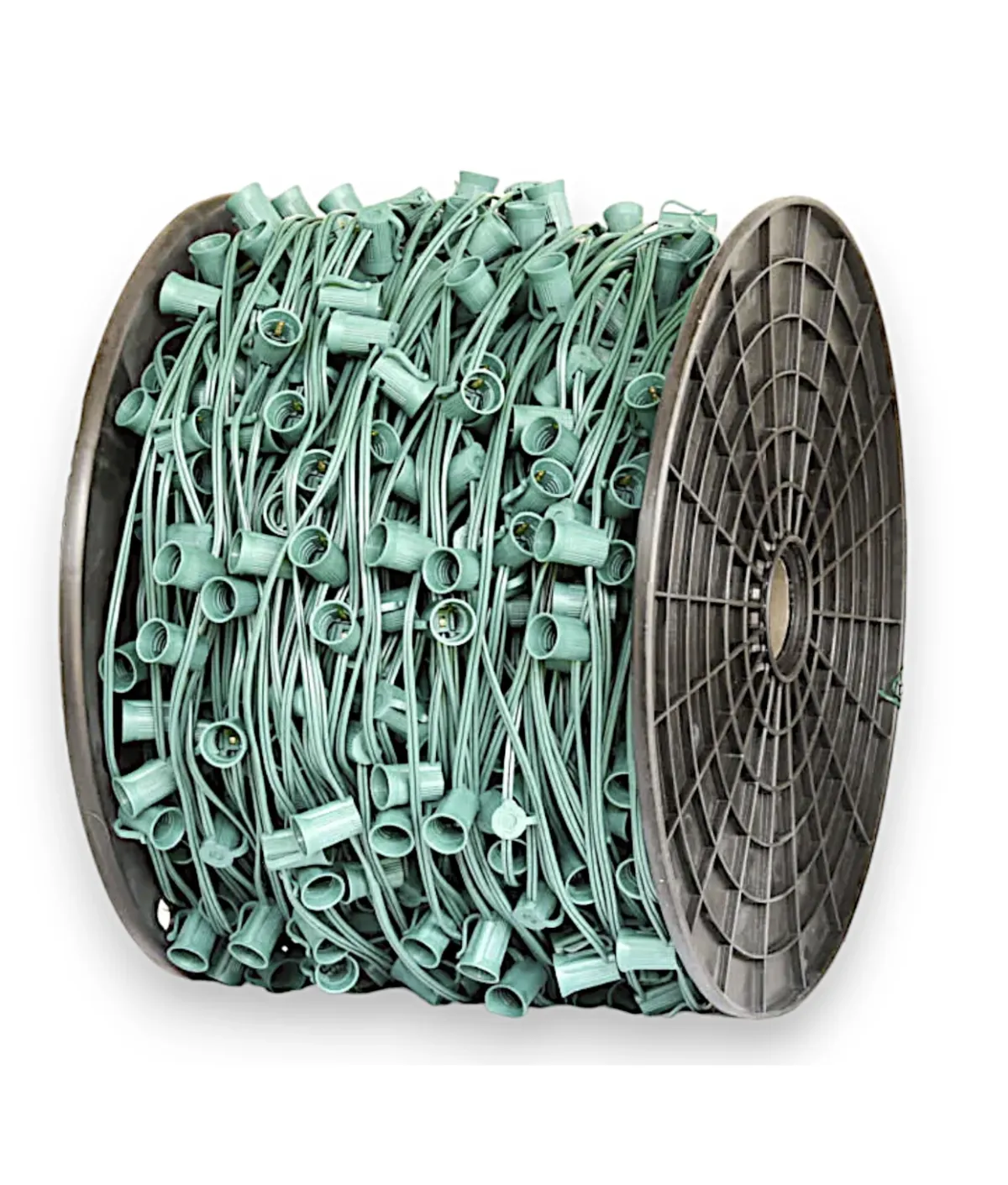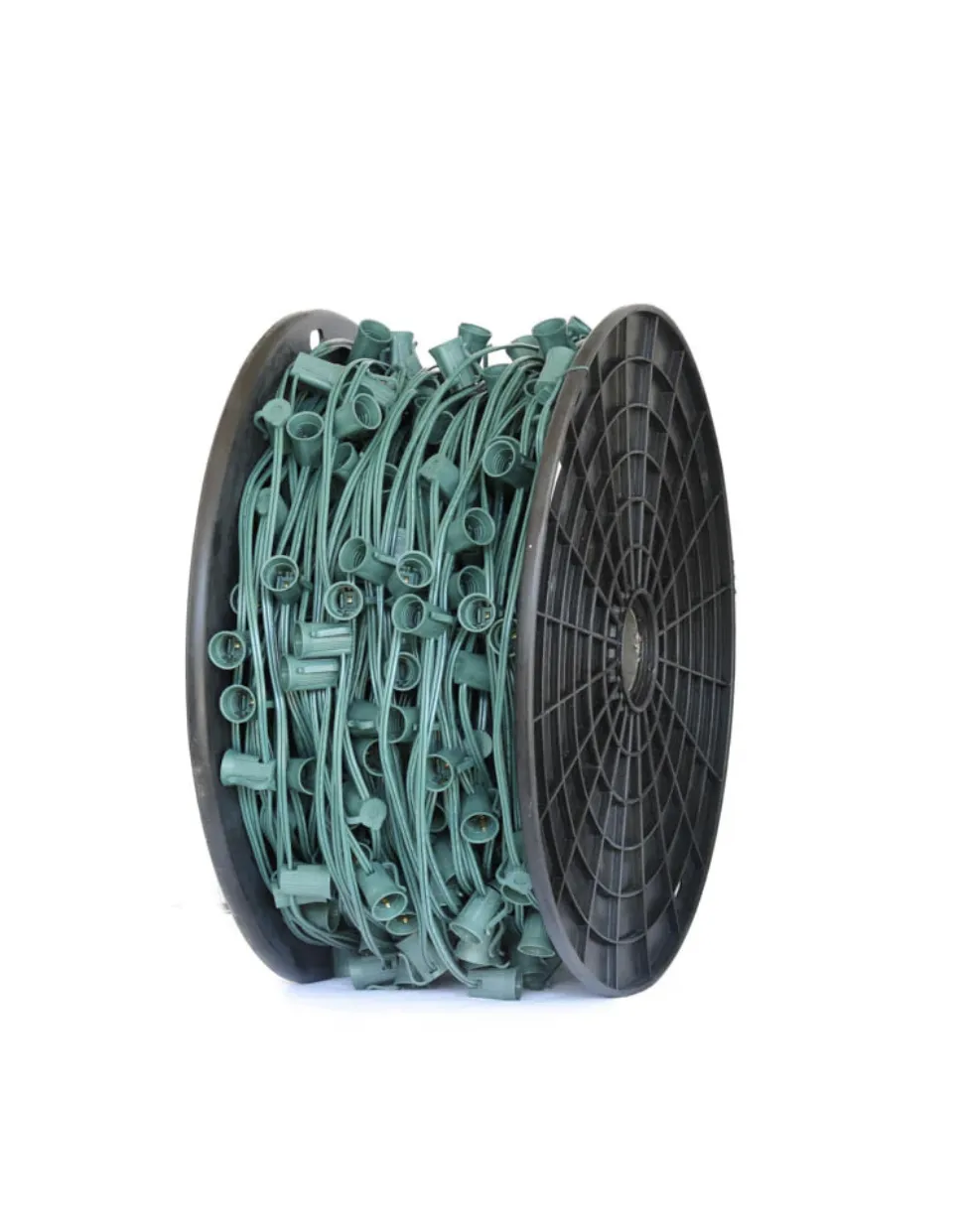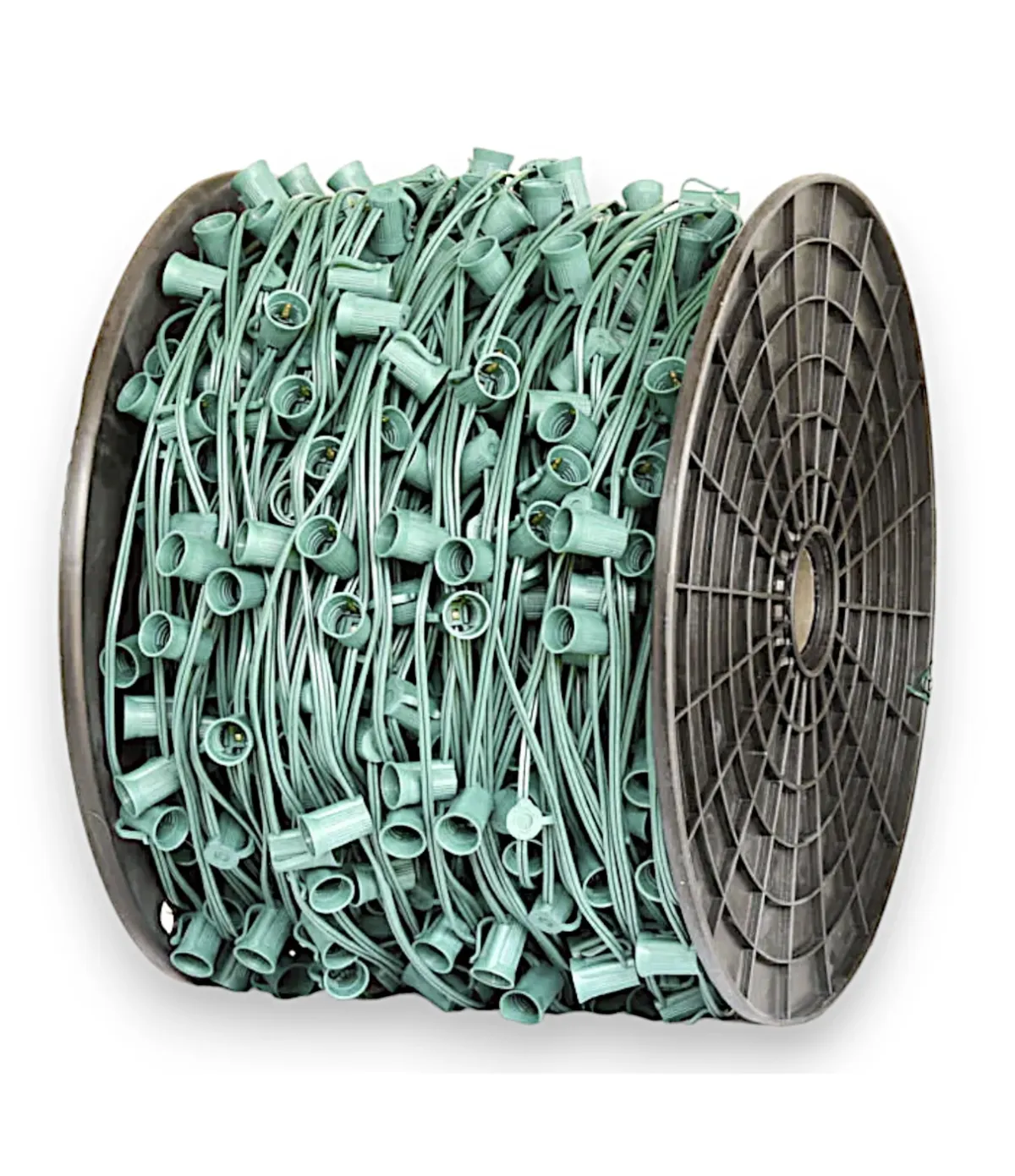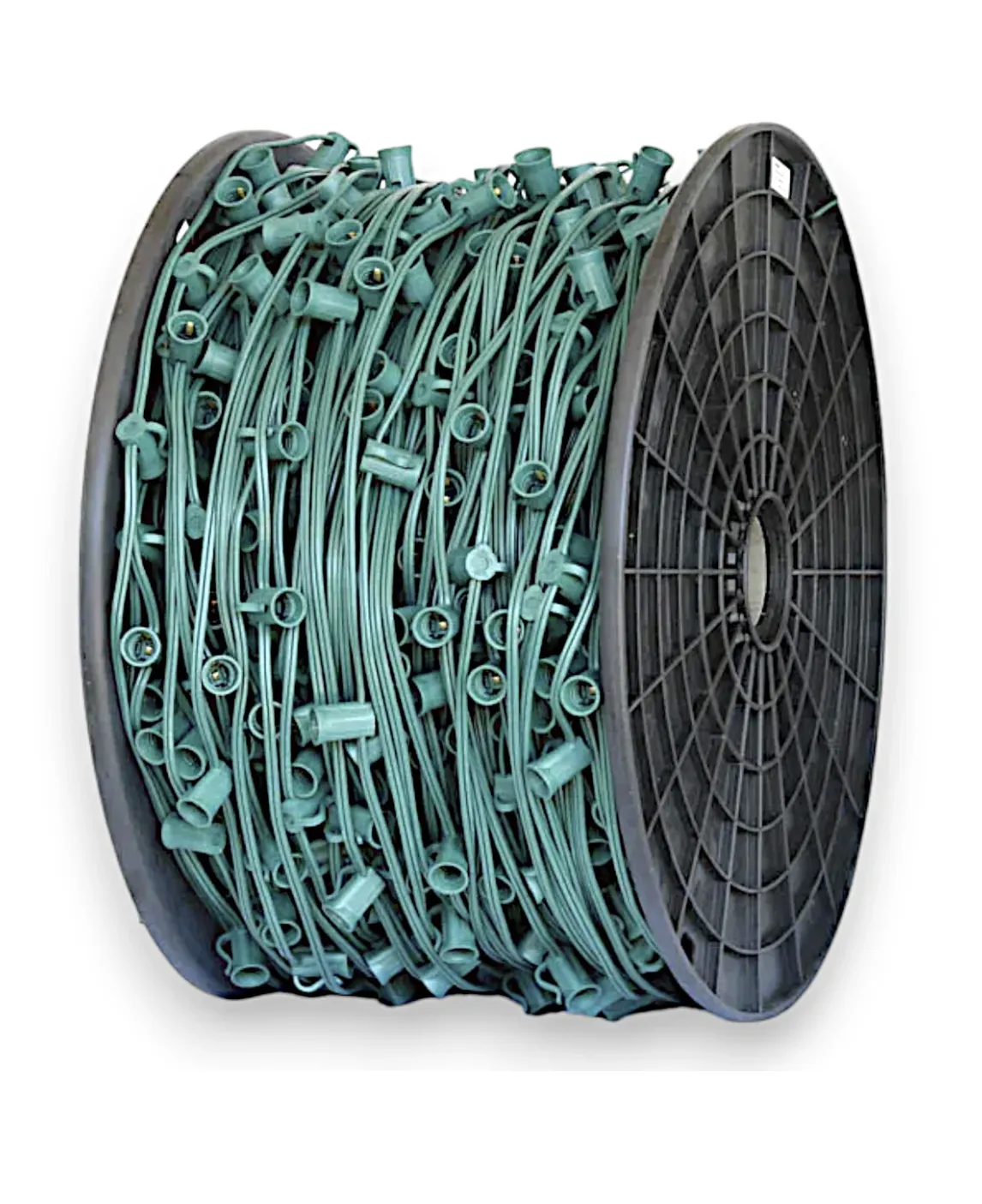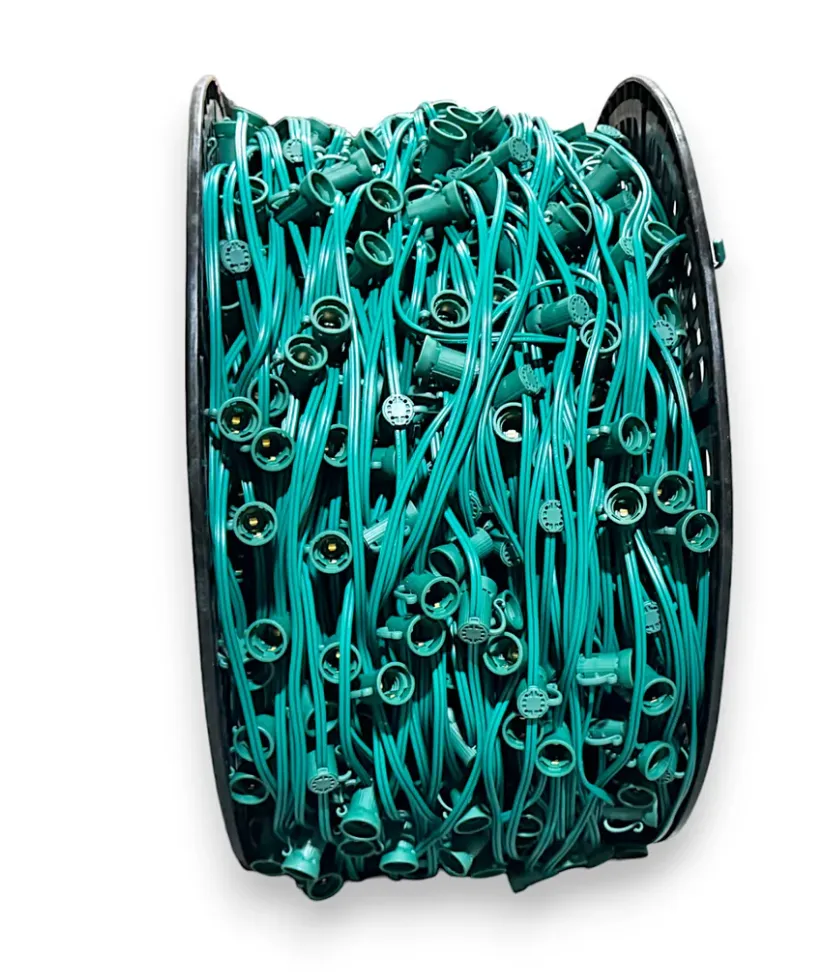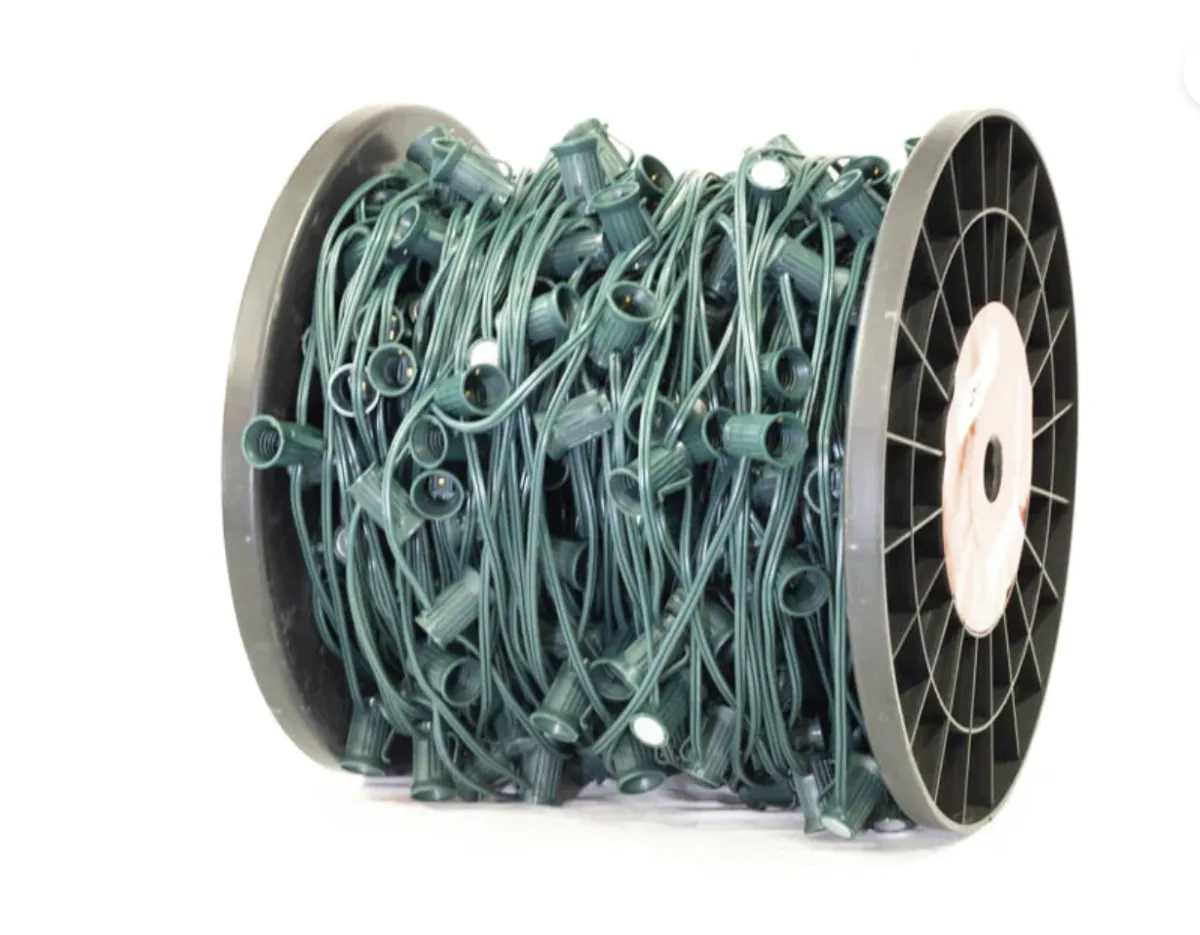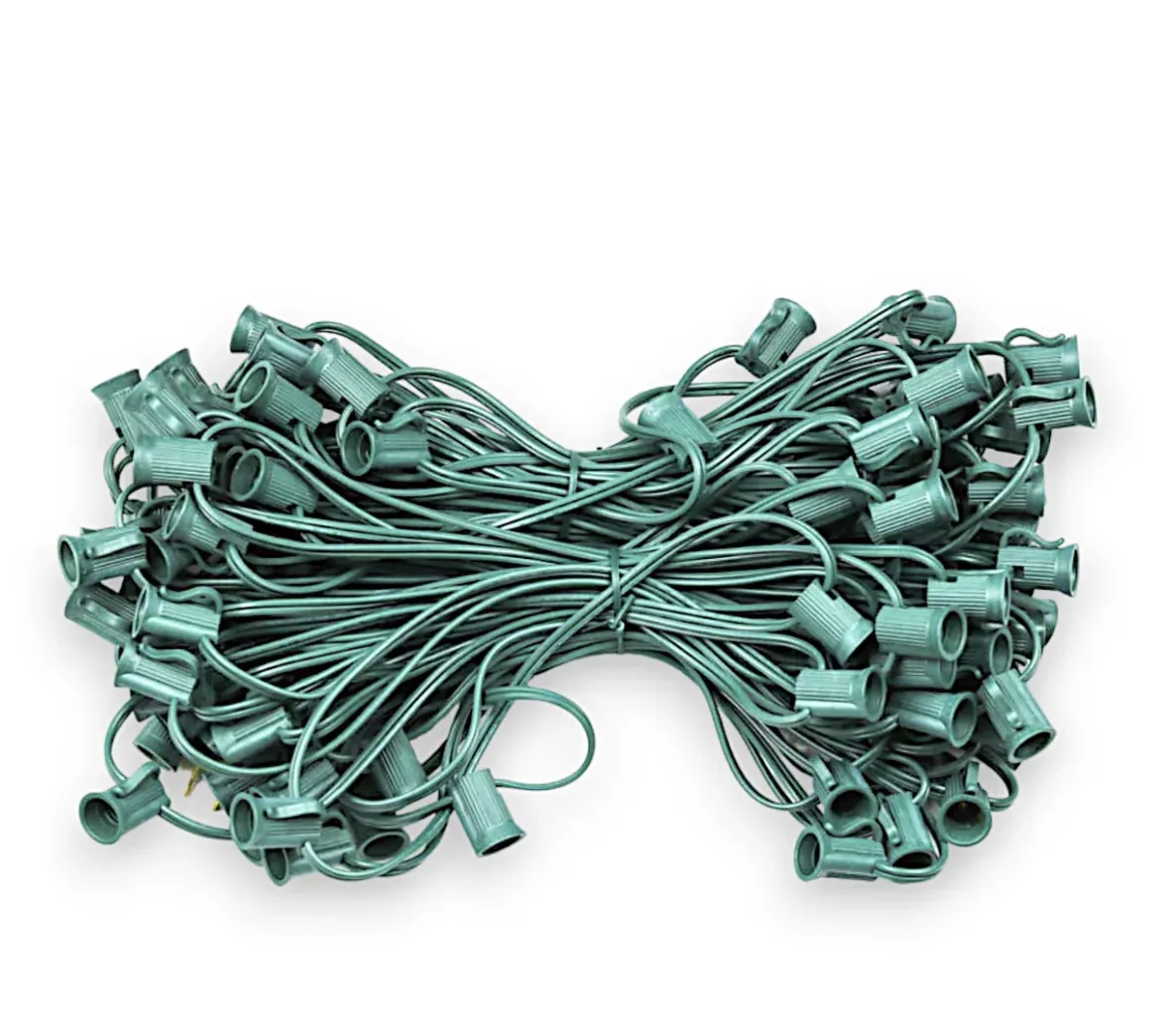C9 & C7 Socket Spools & Stringers
Discover our premium collection of socket wire spools and stringers, the essential foundation for creating stunning light displays. Designed for both professional installers and ambitious homeowners, our range includes bulk C7 and C9 socket wire spools with flexible spacing options, pre-made light stringers for quick setups, and convenient accessories like spool holders. These versatile, durable components are perfect for residential rooflines, enchanting tree displays, and large-scale commercial projects. Suitable for indoor and outdoor use, and compatible with both incandescent and LED bulbs, our professional-grade products offer the quality and flexibility needed to bring your creative lighting visions to life. Explore our selection and elevate your illumination projects with unmatched versatility and reliability.
Socket Spools
C9 1000' Socket Spool
Our C9 1000' Bulk Spool of Socket Wire, available in green or white, offers professional-grade flexibility for custom lighting projects. With spacing options from 6" to 48", it's ideal for both residential rooflines (12-15" spacing) and tree installations (24-48" spacing). The durable SPT-1 wire withstands outdoor conditions and is compatible with both incandescent and LED C9 bulbs. This customizable spool allows for precise length cutting, minimizing waste and maximizing efficiency for high-quality, adaptable lighting displays.
C9 500' Socket Spool
Our C9 500' Bulk Spool of Green Wire, available with 12" (500 sockets) or 15" (400 sockets) spacing, is perfect for professional-grade Christmas lighting installations. Featuring commercial-quality SPT-1, 8-amp wire and durable E17 sockets, this customizable spool is ideal for large-scale outdoor projects. Easily cut to desired lengths and pair with snap-on plugs (sold separately) for tailored lighting solutions in both residential and commercial settings. The 12" spacing offers vibrant, balanced lighting, while the 15" option provides a classic look with fewer bulbs per run.
C9 1000' 12"&15" Socket Wire Spool (SPT-2)
Our C9 1000' Socket Wire Spool (SPT-2) offers professional-grade flexibility with dual 12" and 15" spacing options. This customizable spool features heavy-duty SPT-2 wire for enhanced durability in all weather conditions. The 12" spacing is perfect for dense, vibrant displays on rooflines and pathways, while the 15" option provides a classic look with fewer bulbs per run. Compatible with both incandescent and LED C9 bulbs, this 1000' spool allows for precise cutting to fit any residential or commercial lighting project, ensuring efficient and long-lasting installations.
C7 1000' Green Wire Socket Spool (SPT-2)
Our 1000' bulk spool of green SPT-2 wire features 15" spacing with 1000 C7 sockets, ideal for commercial and residential outdoor displays. This 8-amp (960-watt) commercial-grade wire with Admiral Brand sockets allows for custom-length installations using snap-on plugs (sold separately). Suitable for indoor/outdoor use, it accommodates up to 160 sockets with 5-watt incandescent bulbs or 384 sockets with 1-watt LED bulbs per run. This versatile, durable C7 light line is perfect for creating professional-quality lighting displays in various settings.
C7 1000' Socket Spool
Our C7 1000' Bulk Spool of Socket Wire offers professional-grade flexibility for custom lighting projects. Available in green or white, with spacing options from 12" to 36", it's ideal for both residential rooflines (12-15" spacing) and tree installations (24-36" spacing). The durable SPT-1 wire withstands outdoor conditions and is compatible with both incandescent and LED C7 bulbs. This customizable spool allows for precise length cutting, minimizing waste and maximizing efficiency for high-quality, adaptable lighting displays in various settings.
C9/C7 500' Magnetic Spool
The Fastest Way to Install Holiday Lights on Metal Surfaces. Save time and effort this holiday season with Magnetic Spools. Designed for quick and easy installation, these magnetic spools are perfect for decorating your home or office building. The magnetic sockets eliminate the need for traditional mounting clips, making your installations faster and more efficient. Whether you’re lining rooflines, gutters, or fences, these spools are ideal for any surface where ferrous metal is present.
Available in 500' & 250', 12" or 15" Spacing.
Socket Wire Stringers
C9 12" Spacing Socket Wire Stringers
Our 25', 50' or 100' Holiday Light String features professional-grade, UV-protected 18-gauge wire with sockets spaced 12" apart. Designed for both indoor and outdoor use, these UL-recognized strings offer 5 Amp capacity SPT-1 insulation and durable sockets with weep holes for all-weather performance. Compatible with E12 Candelabra base bulbs (C7, C9, G30; sold separately), these versatile strings allow end-to-end connectivity for extended displays. Perfect for holiday decorations, event lighting, and year-round use in residential and commercial settings. Available in Green, White, Brown and Black.
C7 12" Spacing Socket Wire Stringers
Our professional-grade 25', 50' or 100' light string features sockets spaced 12" apart, perfect for commercial and residential decorators. Designed for both indoor and outdoor use, it's compatible with incandescent or LED C7, G30, and G40 bulbs (sold separately). The SPT-1 insulated wire offers 5 Amp capacity and includes weep-hole sockets for all-weather performance. With male and female plugs for end-to-end connections, these UL-recognized strings can handle up to 480 watts per run. Ideal for holiday displays, patio lighting, and year-round events, these durable strings ensure long-lasting, brilliant illumination for any occasion. Available in Green, White, Brown and Black.
Frequently Asked Questions
What's the difference between socket wire spools and stringers?
cket wire spools are bulk reels of wire with sockets at regular intervals, allowing for custom-length cuts. Stringers are pre-cut lengths of socket wire, typically with plugs attached, ready for immediate use.
Can I use the same socket wire for both C7 and C9 bulbs?
No, C7 and C9 bulbs require different socket sizes. Always check the product specifications to ensure you're using the correct socket wire for your chosen bulb type.
How do I determine the right spacing for my project?
Common spacings are 12", 15", and 24". Use closer spacing (12"-15") for dense, vibrant displays on rooflines or fences. Wider spacing (24" or more) works well for tree wrapping or creating a more subtle effect.
Are these socket wires suitable for outdoor use?
Most of our socket wires are rated for both indoor and outdoor use. Look for products labeled as "weatherproof" or "outdoor-rated" for the best durability in external conditions.
How many bulbs can I safely connect on a single run?
This depends on the wire's amperage rating and the wattage of your bulbs. For example, on an 8-amp wire, you can typically run up to 160 sockets with 5-watt incandescent bulbs or 384 sockets with 1-watt LED bulbs. Always check the product specifications and local electrical codes for safe operation.
Discover Expert Tips on Our Blog

Why Cheap Christmas Light Installs Will Put You Out Of Business!!
As a professional Christmas light installer, one of the most critical aspects of your business is pricing. Proper pricing strategies can make the difference between a thriving business and one that struggles to stay afloat. In this comprehensive guide, we'll explore effective pricing techniques, common pitfalls to avoid, and strategies to maximize your profitability in the competitive world of Christmas light installation.
Understanding the Importance of Proper Pricing
Before diving into specific pricing strategies, it's crucial to understand why proper pricing is so vital for your business. Many Christmas light installation businesses fail not because of a lack of skill or customer demand, but due to financial mismanagement – often stemming from improper pricing.
Consider these sobering statistics: only 25% of businesses make it to the five-year mark. While you might not go out of business in your first year with improper pricing, it's a sure path to eventual failure if not corrected.
The Psychology of Pricing
One common misconception in the industry is that lower prices will automatically lead to more customers. However, this often backfires for several reasons:
1. Lower prices attract price-sensitive customers who are often the most demanding and least loyal.
2. Cheap pricing makes it difficult to afford quality equipment, marketing, and staff training.
3. Low prices can actually make potential customers suspicious of the quality of your work.
Remember, your target market isn't necessarily looking for the cheapest option – they're looking for the best value. This is where your pricing strategy becomes crucial.
Calculating Your Costs
Before setting your prices, you need to have a clear understanding of your costs. Many new business owners make the mistake of only considering direct costs like materials and labor. However, there are numerous hidden costs you need to account for:
- Insurance (general liability, workers comp, vehicle)
- Marketing expenses
- Vehicle maintenance and fuel
- Equipment depreciation and replacement
- Storage costs (especially relevant for Christmas light businesses)
- Administrative costs (including your own time for quoting and planning)
- Taxes
A good practice is to calculate your total annual expenses and divide them by the number of jobs you expect to complete. This gives you a baseline "cost per job" that your pricing needs to exceed for you to be profitable.
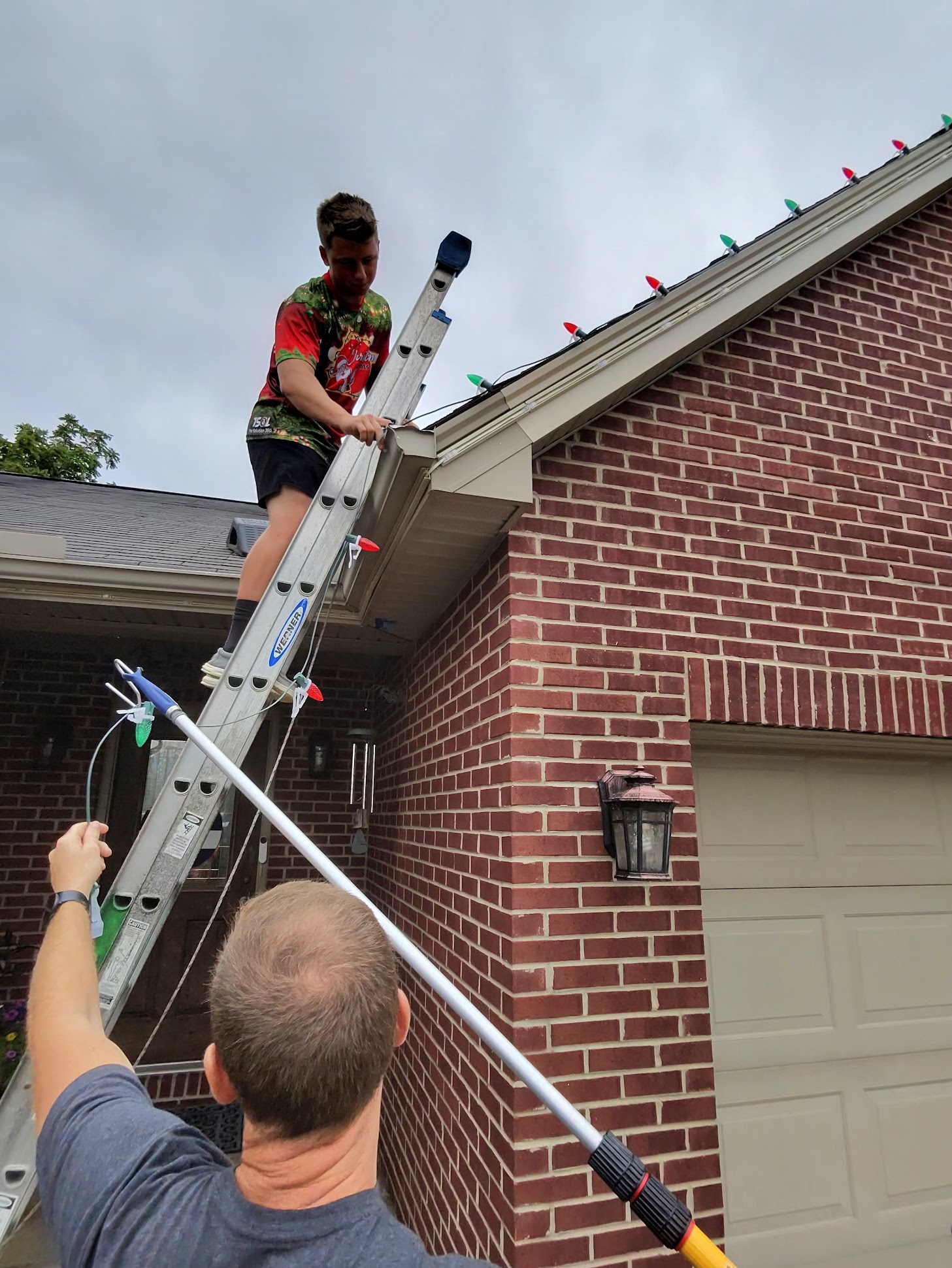
Pricing Strategies for Christmas Light Installation
Now that we understand the importance of proper pricing and have a handle on our costs, let's look at some specific pricing strategies for Christmas light installation.
Per-Foot Pricing
A common and effective method in the industry is to charge per foot of lights installed. Industry standards typically range from $8 to $14 per foot, depending on factors such as your location, the complexity of the installation, and the type of lights used.
Don't be afraid to be at the higher end of this range. Remember, you're not just selling lights – you're selling your expertise, reliability, and the joy and convenience you bring to your customers' holidays.
Pricing for Different Types of Installations
Different types of installations require different pricing strategies:
1. Rooflines: Charge per foot of lights installed, typically between $8 to $14 per foot.
2. Trees: Price based on the height of the tree and the density of lights required.
- For evergreen trees that require lights every 6 inches, charge $40 to $70 per strand.
- For deciduous trees, where lights can be spaced further apart, charge $30 to $50 per strand.
3. Wreaths: Large wreaths (60-inch diameter) can be a profitable add-on. Consider charging $700 to $800 per wreath, even if your cost is significantly lower.
4. Garland: Charge $150 to $180 per 9-foot section. Most doors will require three sections.
Package Pricing
Creating packages can be an effective way to increase your average ticket size. For example, if you have a house that needs 100 feet of lights (at $9 per foot) and a wreath ($400), instead of pricing them separately ($1300 total), create a package price of $1500. This creates a perception of added value for the customer while increasing your profit margin.
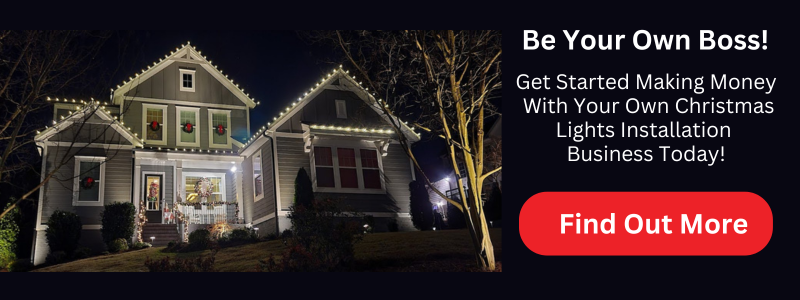
Overcoming Client Objections
When you start pricing at the higher end of the spectrum, you may encounter some client objections. Here are some strategies to overcome them:
1. Focus on Value, Not Price: Don't sell bulbs or techniques. Sell the magic of Christmas, the joy of a beautifully lit home, and the time and stress you're saving the client.
2. Showcase Your Expertise: Highlight your training, experience, and the quality of your materials. Explain why your service is worth the premium.
3. Use Social Proof: Leverage your reviews and testimonials. If you have 500 five-star reviews, make sure potential clients know about it.
4. Offer Comparisons: If a client balks at your price, ask them to consider the cost of purchasing all the materials themselves, the time it would take them to install (and later remove) the lights, and the potential safety risks of doing it themselves.
Growing Your Business Through Pricing
Proper pricing isn't just about survival – it's about creating a business that can grow and scale. Here's why higher pricing is crucial for growth:
1. Hiring and Training: With higher prices, you can afford to hire and properly train staff, allowing you to take on more jobs.
2. Marketing: You'll have the budget for effective marketing campaigns to attract more high-value clients.
3. Equipment: You can invest in better, more efficient equipment, improving your service quality and job completion rate.
4. Customer Service: With better margins, you can afford to go the extra mile for your customers, leading to more referrals and repeat business.
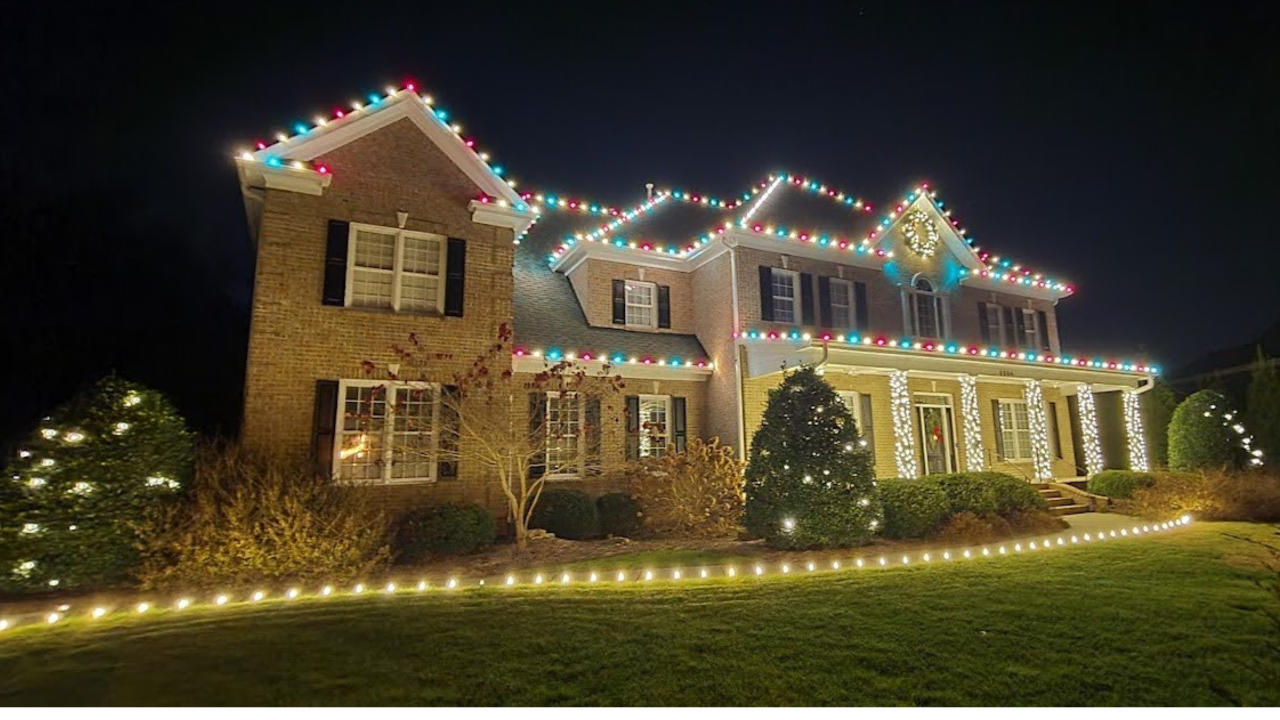
The Importance of Knowing Your Numbers
To price effectively, you need to know your numbers inside and out. This includes:
- Your fixed costs (rent, insurance, etc.)
- Your variable costs per job
- Your capacity (how many jobs you can complete in a season)
- Your close rate (what percentage of quotes turn into jobs)
- Your customer acquisition cost
With this information, you can make informed decisions about your pricing and understand exactly how much you need to charge to meet your financial goals.
Seasonal Considerations
Remember that Christmas light installation is a seasonal business. You need to price your services to ensure you have enough income to cover your annual expenses, even though most of your revenue will come in over just a few months.
Consider offering off-season services like permanent lighting to create year-round income streams and justify higher prices for your installation services.
Continual Improvement and Adjustment
Pricing isn't a set-it-and-forget-it aspect of your business. Regularly review and adjust your prices based on:
- Changes in your costs
- Market demand
- Competitor actions
- Your capacity and workload
Don't be afraid to raise your prices as you gain experience and reputation. Many successful installers find they can increase prices year over year as they become more established.
Building Confidence in Your Pricing
One of the biggest hurdles for many installers is having the confidence to charge premium prices. Remember:
- You are providing a skilled service that requires expertise, equipment, and assumes risk.
- Your time and peace of mind are valuable – price accordingly.
- There are customers out there willing to pay for quality service – your job is to find and serve them, not to appeal to everyone.
Leveraging Technology for Pricing
Consider using customer relationship management (CRM) software to track your quotes, jobs, and customer information. This can provide valuable data to inform your pricing decisions and help you identify your most profitable types of jobs and customers.

The Role of Marketing in Pricing
Your marketing efforts should align with your pricing strategy. If you're positioning yourself as a premium service, your marketing should reflect that. High-quality photos of your work, professional branding, and targeted advertising can all help justify higher prices to potential customers.
Mastering your pricing strategy is a crucial step in building a successful and sustainable Christmas light installation business. By understanding your costs, focusing on value over price, and continually refining your approach, you can create a pricing structure that not only keeps your business afloat but allows it to thrive and grow.
Remember, your goal isn't to be the cheapest option – it's to be the best value for your target market. With the right pricing strategy, you can attract quality clients, provide excellent service, and build a business that brings joy to your customers and success to you.
Take the time to review your current pricing strategy. Are you charging enough to cover all your costs and provide for future growth? Are you confident in the value you provide? If not, it might be time to make some changes. Your future self (and your bank account) will thank you.
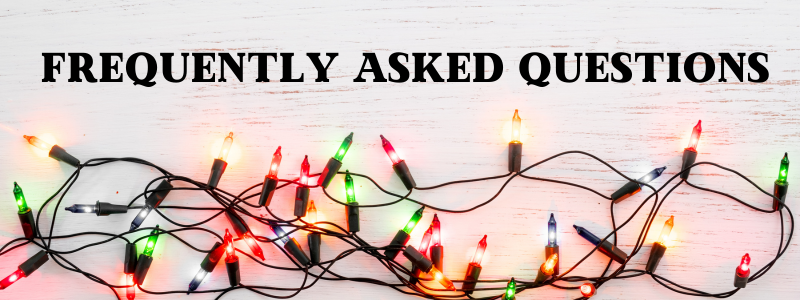
1. Q: What is the recommended price range per foot for Christmas light installation?
A: The industry standard typically ranges from $8 to $14 per foot of lights installed. The exact price within this range depends on factors such as your location, the complexity of the installation, and the type of lights used.
2. Q: How should I price different types of installations, like trees and wreaths?
A: For trees, charge $40 to $70 per strand for evergreen trees (lights every 6 inches) and $30 to $50 per strand for deciduous trees. For large wreaths (60-inch diameter), consider charging $700 to $800 per wreath. Garland can be priced at $150 to $180 per 9-foot section.
3. Q: What hidden costs should I consider when calculating my pricing?
A: Consider costs such as insurance (general liability, workers comp, vehicle), marketing expenses, vehicle maintenance and fuel, equipment depreciation and replacement, storage costs, administrative costs, and taxes. These often-overlooked expenses can significantly impact your bottom line.
4. Q: How can I justify higher prices to potential customers?
A: Focus on the value you provide, not just the price. Highlight your expertise, quality of materials, and the convenience and joy you bring to their holiday season. Use customer testimonials and reviews as social proof of your service quality.
5. Q: Should I offer package deals, and if so, how should I price them?
A: Yes, package deals can be effective. Create packages that combine different services (e.g., roofline lighting plus a wreath) at a slight discount compared to purchasing them separately. This can increase your average ticket size while providing perceived value to the customer.

6. Q: How often should I review and adjust my prices?
A: Review your prices at least annually, preferably before each holiday season. Consider factors such as changes in your costs, market demand, competitor actions, and your capacity and workload when making adjustments.
7. Q: Is it better to position myself as a budget option or a premium service?
A: In most cases, positioning yourself as a premium service is more beneficial. It allows for better profit margins, attracts clients who value quality over price, and provides the resources needed to deliver superior service and grow your business.
8. Q: How can I handle clients who say my prices are too high?
A: Educate the client on the value you provide, including your expertise, quality materials, and the time and stress you save them. Compare your service to the cost and effort of DIY installation. If they're still not convinced, they may not be your target customer.
9. Q: Should I charge differently for commercial and residential installations?
A: While the base per-foot rate might be similar, commercial installations often involve larger scales and more complex setups, which can justify higher prices. Consider factors like increased equipment needs, longer installation times, and potentially off-hours work when pricing commercial jobs.
10. Q: How can I use technology to improve my pricing strategy?
A: Utilize customer relationship management (CRM) software to track your quotes, jobs, and customer information. This data can help you identify your most profitable types of jobs and customers, informing future pricing decisions. Some CRMs also offer features to help with quoting and invoicing, streamlining your pricing process.
Copyright ©2025 All Right Reserved website designed by christmaslights.io
Terms of Service / Privacy Policy
Have questions or need assistance?
Contact us at (855)619-LITE


